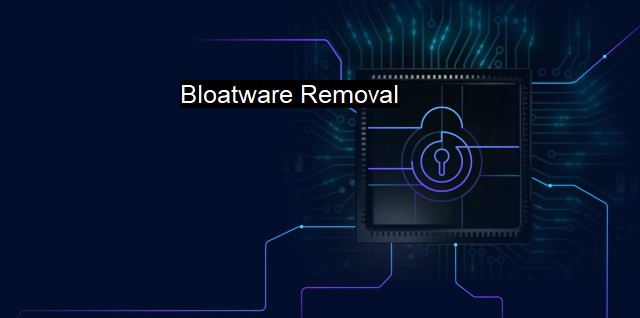What is Bloatware Removal?
Bloatware Removal: The Key to Enhanced Cybersecurity and System Performance
"Bloatware Removal" refers to the process of eliminating unnecessary or unwanted software applications that are preinstalled in a system. It derived its name from being software bloat, or "bloatware," as these programs take up significant storage space in a computer while offering little benefit to the user. The goal is to free up precious memory resources and improve system performance.Most modern-day computer hardware comes pre-equipped with a multitude of software. Some are embedded into standard firmware for the device to operate correctly, like device drivers or any other proprietary software. Others are additions from the manufacturer or retailers to market other facilities or complementary applications. On mobile devices, specifically smartphones, bloatware may refer to preinstalled apps by vendors that users cannot uninstall. These include myriad services or non-core functionality apps, and the user is frequently unable to deter their automated updates.
Bloatware is a concern for various reasons. Apart from consuming storage space, they can critically drain vital resources such as battery life and memory, noticeably slowing down the device's performance. these types of software can open the door to potential cybersecurity risks and vulnerabilities. Despite the seemingly innocuous presence, bloatware can introduce unwanted malice into the device environment against the user's will or knowledge.
These pre-installed apps can harbor vulnerabilities that hackers can exploit. They can spy on user activities, collect data without appropriate permissions, and act as gateways for more forceful cyber attacks - thus, becoming an alternative focus as a security risk point in cyber forensic strategizing. Their presence, hidden within the primarily useful environment of a device, allows them to readily pass firewall or antivirus scans undetected.
This danger necessitates protective measures. Thankfully, one direct line of action as part of an overarching cybersecurity strategy is "Bloatware Removal." The process of "Bloatware Removal" can differ greatly across devices and operating systems. Still, it generally involves user interaction with the device settings to uninstall these unwanted applications one by one manually.
Given the stealthy nature and resistance to removal that many forms of bloatware can exhibit, specialized "Bloatware Removal" tools come as requisite assistance in some cases. These software utilities focus solely on identifying, monitoring, and removing bloatware. They do this function with more effectiveness and intuitive efficiency than most generic device-manager utilities or manual removal attempts.
Antivirus solutions today also often incorporate tools for "Bloatware Removal." These solutions not only scan for conventional threats like malware, Trojans, and viruses but also seek out potential vulnerabilities dangling from signed but unwarranted software services. They then isolate these potential threats and remove them from the system, maintaining the digital hygiene of the device environment.
"Bloatware Removal" has quickly become a significant component of cybersecurity initiatives. It is no longer just about keeping storage free or maintaining optimal performance. In a world progressively reliant on the digital landscape for interactions, the need to safeguard this environment becomes crucial. Removing bloatware conceptually parallels the action of trimming the low hanging branches - winding away the easiest paths for misuse. It forms an elementary step towards ensuring a secure computer ecology.
But it is critical to remember that "Bloatware Removal," while important, is more preventive in nature and forms one comprehensive cog in the cybersecurity defense wheelhouse. Suppose strategically examined under the broader cybersecurity umbrella. In that case, "Bloatware Removal" laces together with sophisticated antivirus protection, firewall defenses, risk mitigation controls, network security, data encryption techniques, user awareness, and a myriad of other aspects colluding to create a robust defensive or preventive cyber mechanism. It empowers users and system administrators to have a safe, efficient, and clutter-free digital experience. In this sense, "Bloatware Removal" becomes part of not just material device management but a substantive representation of computational best practice.

Bloatware Removal FAQs
What is bloatware?
Bloatware refers to pre-installed software that comes with your device or computer. These can be trial versions, games, or other applications that are often unnecessary and take up valuable storage space on your device.Why should I remove bloatware?
Removing bloatware can help improve the performance of your device, as it frees up storage space and reduces the number of programs running in the background. It can also help reduce potential security risks associated with having unnecessary software installed on your device.Can I remove bloatware from my device myself?
Yes, you can remove bloatware from your device yourself. However, it is important to be careful when removing pre-installed software, as some programs may be necessary for the proper functioning of your device. It is recommended to research the software before you remove it, or to use a bloatware removal tool to ensure that you are not removing anything essential.What are some reputable bloatware removal tools?
There are many bloatware removal tools available online, however, it is important to use a reputable and trustworthy tool. Some recommended options include PC Decrapifier, Should I Remove It, and Revo Uninstaller. These tools can help identify and remove unnecessary software from your device quickly and safely.| | A | | | B | | | C | | | D | | | E | | | F | | | G | | | H | | | I | | | J | | | K | | | L | | | M | |
| | N | | | O | | | P | | | Q | | | R | | | S | | | T | | | U | | | V | | | W | | | X | | | Y | | | Z | |
| | 1 | | | 2 | | | 3 | | | 4 | | | 7 | | | 8 | | |||||||